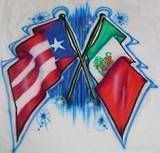 The August 10th issue of the Chicago Reader was all about Logan Square and as expected it was mostly focused on the White/yuppie experience of the neighborhood. I took it as it is, since I don't have expectations for this paper which mostly talks about bars, boutiques, TIFS, to talk about issues that are relevant to a working-class Latina like myself.
The August 10th issue of the Chicago Reader was all about Logan Square and as expected it was mostly focused on the White/yuppie experience of the neighborhood. I took it as it is, since I don't have expectations for this paper which mostly talks about bars, boutiques, TIFS, to talk about issues that are relevant to a working-class Latina like myself.But I was very happy to see that someone, Jesse Mumm (a person I have met and seen at different events), wrote a letter expressing his disappointment that the Reader had glossed over, ignored, or made kitsch, the Latino presence in Logan Square. Here is his letter in its entirety:
August 24, 2007A Piñata Can’t Speak for the Community
I was delighted to see the Reader take on Logan Square in the August 10 issue. I grew up in Logan, attended Darwin School, and have lived, worked, and done research on the near northwest side most of my adult life. There are a million details I wish had been included, but journalists deserve their chance to offer their take on a neighborhood that no one should expect to be summarized in a few articles. I have a lot of personal respect for both Harold Henderson and Ben Joravsky, and all three articles do a good job with other angles on Logan, including the architecture, recent elections, and the early settlement history. But a very crucial piece of the present was treated with cavalier disregard, and its implications are disturbing given the threat gentrification presents to the area.
Logan Square is a Latino community. When I lived on Sawyer and then Washtenaw in the 70s and 80s I was often the only Irish-American kid on the block. My school pictures from Darwin include a few other white kids, mostly Polish, a few black kids, one or two Middle Easterners, among a majority of Latinos. That majority is declining due to gentrification, but only by a few percentage points, as recent immigration is bringing new Latinos to Logan Square at the same time. In the Henderson piece [“It Started With a Farm”], the last three generations of a majority Latin-American neighborhood deserve more than an addendum at the end of a list of immigrant groups here: “now Latinos.” In fact nowhere in the opening blurb or subsequent three articles does the phrase “Puerto Rican” ever appear, although at its inception this Latino community was majority Puerto Rican, and adjacent to the historic heart of Puerto Rican Chicago in Humboldt Park. The funny-looking piñata on the cover represents the Mexican community here as kitsch, and very little in the articles lets them speak as people. Why a single Cuban former resident now in Miami got the only extensive interview about the current Latino community and its history boggles my mind in a neighborhood with so many outspoken Latino leaders and residents still there. Relying on this expatriate meant mistakes as well: Los 4 Caminos was not there in 1972, and the “Cubans on the east” of Kimball were a fraction of the Puerto Rican and Mexican presence. Joravsky [“End of an Era”] does not actually explain much promised in his subtitle about “how Logan Square got out from under powerful alderman Richard Mell.” There is a much more interesting story behind all this, of long-standing battles between the emergent progressive Puerto Rican leadership and Mell’s decreasing ability to buy off Latinos, who forced him in the late 90s to negotiate. Instead white “independents” become the protagonists of the community in his narrative, rather than a privileged minority largely arguing over issues that revolve mostly around low-income Latinos.
What was missed in all this? Not only has Logan Square been majority Latino for many generations, but it is the only neighborhood in Chicago that has been a strong port of entry for all of its major Latino groups, including Puerto Ricans, Mexicans, Cubans, and Central Americans. I had close friends and neighbors from all those places. The future of this country has a lot to do with whether Latinos over time decide to form a cultural and political whole, and Chicago provides a fascinating window into this experiment in action in Logan Square. Unfortunately that gets missed when we are looking more for amenities and curiosities than people. Part of the new backlash against people who are angry and frustrated about the displacement of longtime residents is contained in the gloss of “diversity” that strategically wipes Latinos from the picture. Often newcomers find the preceding white European immigrants and the new eclectic eating spots more interesting than the legacies of families, events, moments, and organizations that Latinos represent in Logan—let alone their present reality. Many well-intentioned white progressives never find their way into Latino social circles here and largely live in a “parallel Logan,” shopping at different stores, finding other white hipsters in cafes, and sampling Latino culture mostly as late-night tacos. The articles got many things right, but they mostly missed the Latino community, who remain 65 percent of the people of Logan Square. That omission would be pretty unconscionable in Chinatown or Devon or Paseo Boricua, but gets a pass here because the real-estate boosters have done their work and sold us an image in which most of the neighbors cannot find themselves—except as backdrop. We are reading an imbalanced landscape, through the eyes of gentrification. The real one is much more interesting.
Anthropologist
So finally a little bit of truth and funny too. I think I'll start using the term "parallel Logan" myself.
But of course, in the next issue, there had to be a right-winger using a very hackneyed argument. Here's his letter:
I want to write a letter to this Mike, but his uninspired arguments make me just want to give up!Speaking of Displaced Communities
The first thing I noticed about Jesse Mumm’s extensive letter to the Reader [“A Piñata Can’t Speak for the Community,” August 24] about the lack of coverage of the resident Latino community in Logan Square [The Logan Square Issue, August 10] was that his signature contains the title “anthropologist.” I find it humorous that Mr. Mumm states indignation about the frustration of longtime Latino residents being displaced in the name of gentrification disguised as diversity. I always thought anthropologists that were worth their weight looked at the entire historical record. Had Mr. Mumm did that, he would have found that the Latinos actually displaced an established core of Scandinavian and eastern European families in the late 1960s and early 1970s. So the term longtime Latino residents somehow hits a sour note with me.
In addition, the Cuban influence in Logan Square in the early 70s was perhaps more significant than that of any other Latino group. Cubans represented a large cross section of hardworking people in blue- and white-collar jobs and many who owned their own businesses early in that transformation. There were even some notorious incidents. That there were halfway houses in Logan Square for Marielito boat people taken in by the benevolent President Ronald Reagan in the early 1980s is an established fact. Back in the 1950s, Polish Constitution Day was a huge event in Humboldt Park drawing thousands of Polish locals. Flash cut to the 1970s and it became a Cinco de Mayo celebration. That Logan Square has gone full circle in over just a handful of generations seems lost on the anthropologist named Jesse Mumm.
Wait- did this idiot just call Reagan "benevolent" ?!?! WTF?!
FTP



